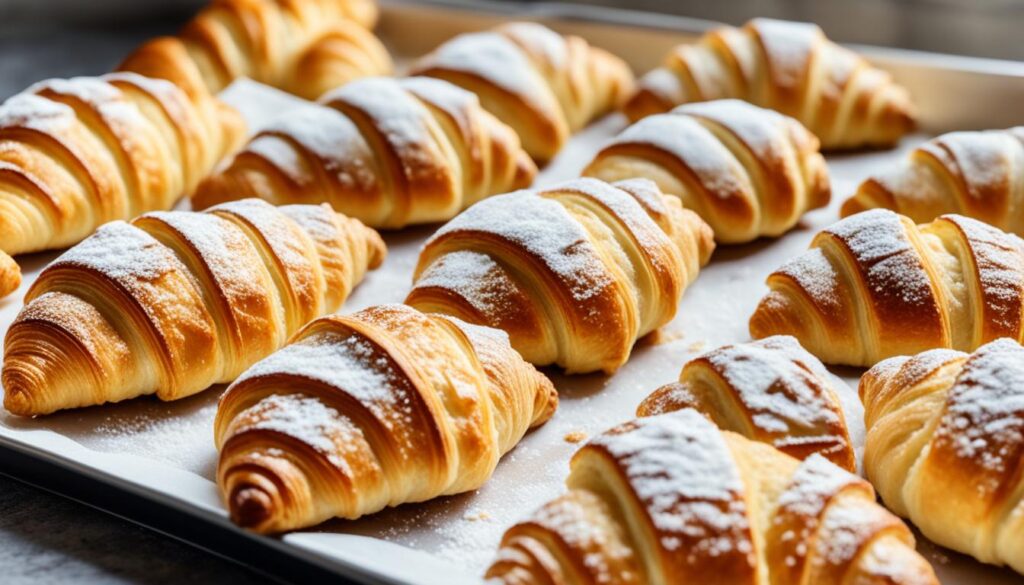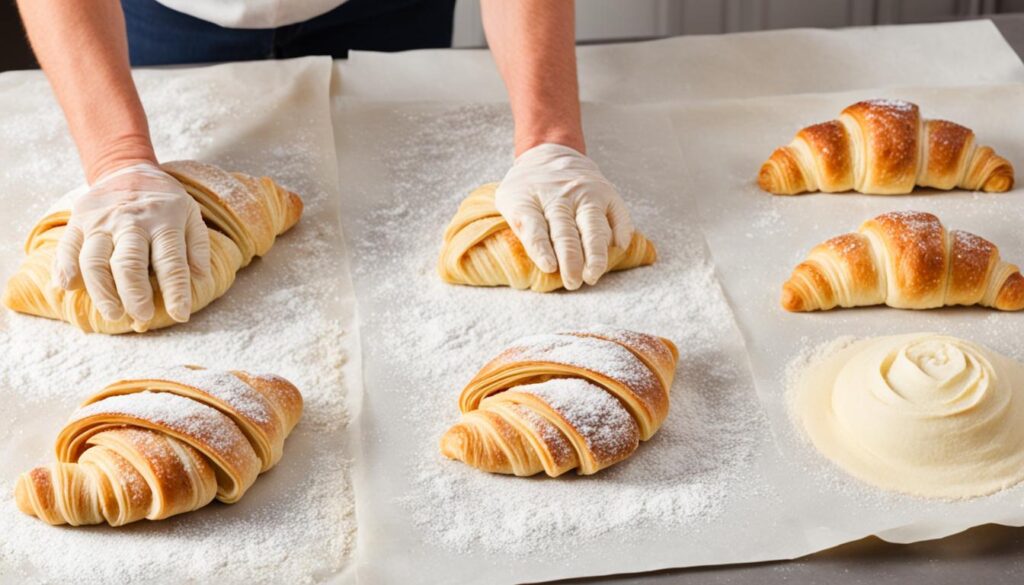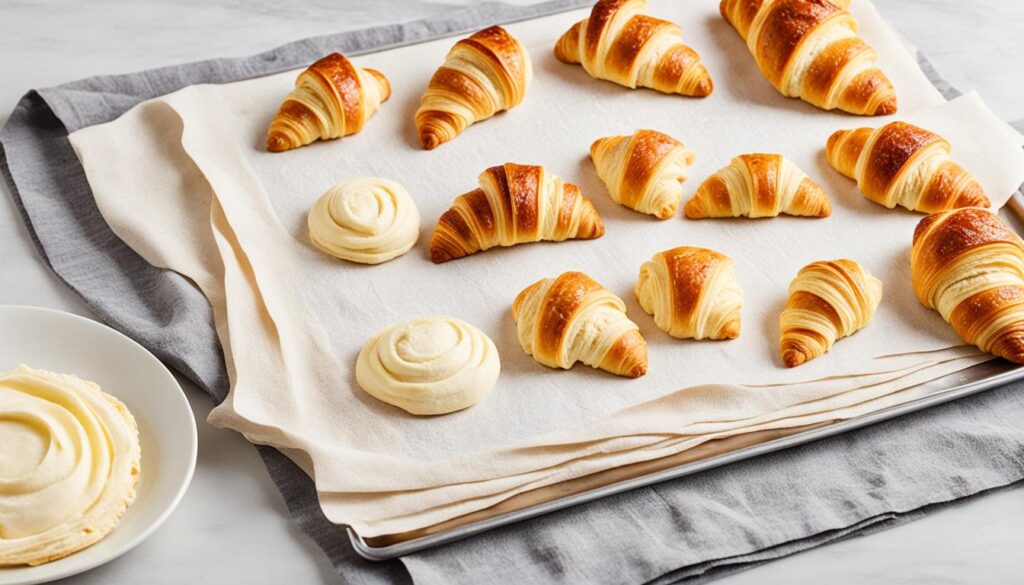Welcome to the world of baking with our Perfect Croissants Recipe! Making croissants at home is exciting and rewarding. It brings the taste of a French bakery to your kitchen. The process might look hard, but with time and effort, you can make these golden brown, flaky pastries. They’re sure to impress everyone.
With our step-by-step guide and tips, you’ll learn to make croissants Recipe. They’re perfect for breakfast or any special occasion. Get ready for a fun baking journey. Enjoy making and sharing your own delicious croissants!

Key Takeaways
- You’ll learn to recreate classic croissants at home.
- The recipe yields 8 to 12 croissants depending on specific methods used.
- Perfecting your skills will allow you to achieve a deliciously flaky texture.
- Ingredient quality, like fresh butter and premium flour, is key to success.
- Attention to detail during the lamination process determines the final taste.
- Allowing enough resting time for the dough is crucial for optimal results.
Understanding Croissants and Their History
The story of croissants is rich and fascinating, tracing back to Austria. The kipferl, a pastry that came before croissants, was first mentioned in 1227. It was given as a Christmas gift to Duke Leopold. This pastry then moved to France, thanks to August Zang, an Austrian artillery officer. He opened a Viennese bakery in Paris in 1839.
This was a big moment for croissants. Zang’s Boulangerie Viennoise introduced French people to a new pastry. It was made from a buttery yeast-leavened dough that was layered perfectly.
The Origins of Croissants Recipe
The name “croissant” first showed up in a Parisian dictionary in 1863. This shows how the pastry became a big part of French culture. In 1915, Sylvain Claudius Goy made a big change. He used laminated yeast dough instead of traditional brioche in his recipe.
Today, viennoiserie includes croissants and other similar pastries. This shows the big influence of Vienna on French pastries.
The Evolution of the Croissant
The croissant has changed a lot over the years. It became a favorite around the world. In the 1970s, margarine started being used instead of butter in making croissants Recipe .
Some croissants Recipe are marked as AOP. This means they use high-quality butter from Poitou-Charentes. This butter tastes fruity and works well in the dough. As croissants became more popular, making them on a large scale made them easier to get. This shows how this pastry has spread all over the world.
| Year | Significant Event |
|---|---|
| 1227 | First mention of the kipferl as a Christmas gift |
| 1839 | Introduction of the kipferl to France by August Zang |
| 1863 | Term “croissant” enters Parisian dictionary |
| 1915 | First known French croissant recipe documented |
| 1920 | French government recognizes croissant as national product |
| 1981 | Sara Lee pioneers freezing croissant dough |
Essential Ingredients for Perfect Croissants
Getting ready to make croissants Recipe? Choosing the right ingredients is key. Each one is important for that flaky, buttery taste we all love. Knowing about flour types, butter quality, and yeast will make baking better.
Types of Flour to Use
The right types of flour are crucial. All-purpose flour is a top choice with 11% protein. It works well for croissants Recipe. Or try bread flour for a chewier texture and better layers.
A small batch recipe is great for home bakers. It’s easy and doesn’t overwhelm you with too much dough.
The Role of Butter in Croissant Making
Good butter for croissants Recipe is a must. Pick unsalted European butter for its 82-84% fat. This makes the croissants soft and tasty. Avoid salted butter to prevent a hard texture.
Shape the butter into a rectangle and chill it. This keeps it at the right temperature for lamination.
Choosing the Right Yeast
Choosing the right yeast is key for a good rise. Use active dry yeast or substitute with instant yeast. You can also use less, about 25% less.
This yeast makes the dough light and airy. Resting the dough lets you take a break while it works its magic.
Preparing the Dough for Your Croissants Recipe
Making the dough right is key to great croissants Recipe. This part talks about the détrempe, the base of your dough. It also covers important steps like controlling the dough’s temperature for the best results.
Making the Détrempe (Dough)
For détrempe, mix the ingredients carefully for a good dough. You’ll need 4 cups plus 1 tablespoon (577g) of flour, 1½ cups (360g) of warm water, and ¼ cup plus 1 tablespoon (65g) of sugar.
Add 2 teaspoons of salt for flavor and use European-style butter with 82% butterfat for richness and softness.
Be careful not to mix too much to avoid a tough dough.
Importance of Temperature Control
Keeping the right temperature is key when making croissant dough. Keep the butter at about 55°F for good lamination and rising.
Let the dough rise for 1½ to 2 hours to get it big enough. The right temperature helps the yeast work well for a light texture.
Chill the dough for at least 2 hours or overnight for better flavor and texture. Folding the dough 5 times makes it extra flaky.
| Ingredient | Quantity |
|---|---|
| All-Purpose Flour | 4 cups plus 1 tablespoon (577g) |
| Warm Water | 1½ cups (360g) |
| Granulated Sugar | ¼ cup plus 1 tablespoon (65g) |
| Salt | 2 teaspoons |
| European-style Butter | 1½ cups (339g) |
Laminating the Dough: The Key to Flakiness
The lamination process is key to making flaky croissants. It’s about folding butter into the dough in specific steps. This makes the croissants Recipe light and airy.
What is Lamination?
Lamination means putting cold butter in dough and rolling and folding it many times. This makes over 80 layers of dough and butter. It makes each bite flaky and adds a buttery taste. When baking, the butter’s moisture turns into steam. This makes the layers even flakier.
Steps to Properly Laminate Croissant Dough
To get good at lamination, follow these steps:
- Start with 46 ounces of King Arthur Unbleached All-Purpose Flour and 27 ounces of water. Make sure your butter has at least 83% butterfat.
- Make your butter block into a 7 1/2-inch square and chill it for 15 minutes.
- Roll your dough into a 12-inch square, putting the butter block in the middle.
- Fold the dough in thirds, chill it for 45 minutes, and roll and fold it again two times.
- Let the dough rest and chill for at least 2 hours before making croissants Recipe.
Learning these steps helps you make not just flaky croissants but also tasty variations like Pain au Chocolat.

Shaping Your Croissants Recipe
Shaping croissants is key to making them perfect. You need to use the right cutting techniques for the best shape. Start by rolling the dough into rectangles, aiming for a length of 75 cm and a width of 35 cm.
Then, trim the edges for neatness. Next, cut your dough into triangles. Aim for a size of 9 cm wide and 15 cm long for the best layers.
How to Cut and Shape the Dough
After rolling out your dough, cut it into two long strips. This makes it easier to create different shapes. Each strip should be cut into triangles for uniformity.
Remember to stretch the dough gently while rolling. This keeps the layers airy and prevents the croissants from becoming dense. You can make 12 to 14 croissants or pastries this way.
Tips for Achieving the Perfect Crescent Shape
To get that crescent shape, roll the triangle from the base to the tip. Use light pressure to shape the croissants Recipe without losing the air pockets. After rolling, curve the croissant slightly before placing it on the tray.
Keep your kitchen draft-free to prevent dough melting. The right temperature is crucial, especially with buttery dough, to avoid melting.
Proofing and Baking Your Croissants Recipe
Getting your croissants to proof right is key for that perfect texture. It lets the dough rise well, making each croissant flaky and light. You should let your shaped croissants proof for about 2.5 hours at 73-75 degrees Fahrenheit. This first rise helps the yeast work, making the dough expand.
The Importance of Proofing for Texture
The proofing stage changes the dough a lot, making it better in the end. If the dough doesn’t proof enough, it can be heavy and not flaky. Watch your dough closely. You want it to be soft and puffy before baking.
Setting the Right Oven Temperature
The oven temperature is crucial for croissants Recipe. Heat your oven to 425ºF and bake for 18 minutes. Then, lower the temperature to 400ºF for the rest of the time. Keep an eye on them as they bake, looking for a deep golden color. Adjust the time if needed, as baking takes 18 to 22 minutes. Paying attention to temperature and time will help get the perfect crust and inside.

Tips and Tricks for Success with Croissants Recipe
Making croissants Recipe can be rewarding, but it takes the right steps. Knowing common mistakes helps make sure your croissants are perfect. Here are some tips to help you.
Common Mistakes to Avoid
One big mistake is not keeping the dough cold. This stops the butter from melting and ruining the layers. Always refrigerate or freeze the dough between steps.
Using too much flour when rolling can also cause problems. It makes the layers not stick together right. Use a ruler for measuring to get sharp corners on the butter and dough. This is key for making croissants Recipe.
Tools and Equipment for Home Bakers
You don’t need fancy tools, but some are very helpful. A strong rolling pin, a ruler, and a sharp knife make a big difference. Use European-style butter like Kerrygold for the best flaky layers.
A baking thermometer is also key. It helps you keep an eye on the temperature. Here’s a list of tools you’ll need for making croissants Recipe:
| Tool | Purpose |
|---|---|
| Rolling Pin | Evenly rolls dough for lamination |
| Ruler | Ensures precise measurements |
| Sharp Knife | Perfects the cutting and shaping process |
| Baking Thermometer | Monitors oven temperatures accurately |
| Silicone Baking Mat | Prevents sticking and aids with rolling |
Even with mistakes, you can learn and improve. Paying attention to common mistakes and using the right tools will help you make great croissants Recipe.
Conclusion
Making perfect croissants at home is a rewarding journey. It mixes tradition with technique. You start by learning about the key ingredients and then work on lamination.
This recipe makes 24 croissants Recipe. It needs 12g of dried yeast and a 280g butter block. Making them is detailed work. But the end result is croissants that are crispy outside and soft inside.
Don’t be scared of the learning curve. It’s part of making your perfect croissants Recipe. Every try teaches you something new, like trying different flours or improving the proofing. When you roll out the dough right and layer it well, you get a great result. Small changes can make a big difference in taste and texture.
Keep trying new things and don’t give up. With hard work and patience, baking becomes fun. So, get your ingredients ready, follow the steps carefully, and enjoy the tasty results of your effort.
FAQ
What is the key to making flaky croissants Recipe?
The secret to flaky croissants is the lamination process. This means folding cold butter into the dough many times. This creates layers that make the croissant rise and gives it that flaky feel.
Can I use all-purpose flour instead of bread flour for croissants Recipe?
You can try using all-purpose flour, but bread flour is better. It has more protein. This helps the gluten develop better, making the croissant chewier and more structured.
How do I choose the right yeast for my croissant recipe?
You can pick between active dry yeast or instant yeast. Instant yeast is quicker and doesn’t need proofing. It’s great for home bakers who want an easier process.
What is the best temperature for proofing croissants Recipe?
Proofing croissants should be at 75°F to 80°F. This warmth helps the dough rise and develop texture. Don’t let it get too cold, as this slows down the yeast.
How long should I let my croissants proof before baking?
Let your croissants proof for 1 to 2 hours, or until they’ve doubled in size. Watch the dough closely, as the time can change with the temperature.
What common mistakes should I avoid when making croissants?
Avoid not keeping the dough at the right temperature, overworking it, and not proofing it enough. Stick to the steps carefully for the best results.
Do I need special equipment to make croissants Recipe at home?
You don’t need fancy gear, but a rolling pin, sharp knife, and baking sheet help. A mixing bowl and kitchen scale for precise measurements are also good to have.
Can I prepare the croissant dough in advance?
Yes, you can make the croissant dough early. Wrap it well and refrigerate for up to 24 hours or freeze it for longer. Then, shape and proof it before baking.
Read also: Delicious Gipfeli Recipe: Made Simple
